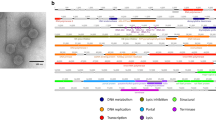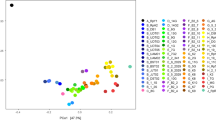Abstract
Bacteriophage vB_PpaP_PP74 (PP74) is a novel virulent phage that infects members of the species Pectobacterium parmentieri, a newly established species of soft-rot-causing bacteria in the family Pectobacteriaceae, derived from potato-specific Pectobacterium wasabiae. vB_PpaP_PP74 was identified as a member of the family Podoviridae by transmission electron microscopy. The phage has a 39,790-bp dsDNA genome containing 50 open reading frames (ORFs). Because of the absence of genes encoding toxins or lysogeny factors, PP74 may be considered a candidate phage for pathogen biocontrol applications. The genome layout is similar to genomes of T7-like phages within the subfamily Autographivirinae, and therefore, functions can be attributed to most of ORFs. However, the closest nucleotide sequence homologs of phage PP74 are unclassified Escherichia phages. Based on phylogenetic analysis, vB_PpaP_PP74 is a sensu lato T7-like phage, but it forms a distant subgenus group together with homologous enterobacterial phages.


Similar content being viewed by others
References
Pérombelon MCM (2002) Potato diseases caused by soft rot erwinias: an overview of pathogenesis. Plant Pathol 51:1–12. https://doi.org/10.1046/j.0032-0862.2001.Shorttitle.doc.x
Toth IK, van der Wolf JM, Saddler G et al (2011) Dickeya species: an emerging problem for potato production in Europe. Plant Pathol 60:385–399. https://doi.org/10.1111/j.1365-3059.2011.02427.x
Czajkowski R, Grabe GJ, van der Wolf JM (2009) Distribution of Dickeya spp. and Pectobacterium carotovorum subsp. carotovorum in naturally infected seed potatoes. Eur J Plant Pathol 125:263–275. https://doi.org/10.1007/s10658-009-9480-9
Czajkowski R, Pérombelon MMCM, Jafra S et al (2015) Detection, identification and differentiation of Pectobacterium and Dickeya species causing potato blackleg and tuber soft rot: a review. Ann Appl Biol 166:18–38. https://doi.org/10.1111/aab.12166
Khayi S, Cigna J, Chong TM et al (2016) Transfer of the potato plant isolates of Pectobacterium wasabiae to Pectobacterium parmentieri sp. nov. Int J Syst Evol Microbiol 66:5379–5383. https://doi.org/10.1099/ijsem.0.001524
Nykyri J, Niemi O, Koskinen P et al (2012) Revised phylogeny and novel horizontally acquired virulence determinants of the model soft rot phytopathogen Pectobacterium wasabiae SCC3193. PLoS Pathog. https://doi.org/10.1371/journal.ppat.1003013
Smolarska A, Rabalski L, Narajczyk M, Czajkowski R (2017) Isolation and phenotypic and morphological characterization of the first Podoviridae lytic bacteriophages ϕA38 and ϕA41 infecting Pectobacterium parmentieri (former Pectobacterium wasabiae). Eur J Plant Pathol. https://doi.org/10.1007/s10658-017-1289-3
Van Twest R, Kropinski AM (2009) Bacteriophage enrichment from water and soil. Methods Mol Biol 501:15–21. https://doi.org/10.1007/978-1-60327-164-6_2
Lavigne R, Seto D, Mahadevan P et al (2008) Unifying classical and molecular taxonomic classification: analysis of the Podoviridae using BLASTP-based tools. Res Microbiol 159:406–414. https://doi.org/10.1016/j.resmic.2008.03.005
Bankevich A, Nurk S, Antipov D et al (2012) SPAdes: a new genome assembly algorithm and its applications to single-cell sequencing. J Comput Biol 19:455–477. https://doi.org/10.1089/cmb.2012.0021
Besemer J, Lomsadze A, Borodovsky M (2001) GeneMarkS: a self-training method for prediction of gene starts in microbial genomes. Implications for finding sequence motifs in regulatory regions. Nucleic Acids Res 29:2607–2618. https://doi.org/10.1093/nar/29.12.2607
Hyatt D, Chen G-L, Locascio PF et al (2010) Prodigal: prokaryotic gene recognition and translation initiation site identification. BMC Bioinform 11:119. https://doi.org/10.1186/1471-2105-11-119
Aziz RK, Bartels D, Best AA et al (2008) The RAST server: rapid annotations using subsystems technology. BMC Genom 9:75. https://doi.org/10.1186/1471-2164-9-75
Altschul SF, Madden TL, Schäffer AA et al (1997) Gapped BLAST and PSI-BLAST: a new generation of protein database search programs. Nucleic Acids Res 25:3389–3402. https://doi.org/10.1093/nar/25.17.3389
Sievers F, Wilm A, Dineen D et al (2011) Fast, scalable generation of high quality protein multiple sequence alignments using Clustal Omega. Mol Syst Biol 7:539
Stamatakis A (2014) RAxML version 8: a tool for phylogenetic analysis and post-analysis of large phylogenies. Bioinformatics 30:1312–1313. https://doi.org/10.1093/bioinformatics/btu033
Schattner P, Brooks AN, Lowe TM (2005) The tRNAscan-SE, snoscan and snoGPS web servers for the detection of tRNAs and snoRNAs. Nucleic Acids Res. https://doi.org/10.1093/nar/gki366
Lavigne R, Sun WD, Volckaert G (2004) PHIRE, a deterministic approach to reveal regulatory elements in bacteriophage genomes. Bioinformatics 20:629–635. https://doi.org/10.1093/bioinformatics/btg456
Klucar L, Stano M, Hajduk M (2009) PhiSITE: database of gene regulation in bacteriophages. Nucleic Acids Res. https://doi.org/10.1093/nar/gkp911
Mertens H, Hausmann R (1982) Coliphage BA14: a new relative of phage T7. J Gen Virol 62:331–341. https://doi.org/10.1099/0022-1317-62-2-331
Chen M, Xu J, Yao H et al (2016) Isolation, genome sequencing and functional analysis of two T7-like coliphages of avian pathogenic Escherichia coli. Gene 582:47–58. https://doi.org/10.1016/j.gene.2016.01.049
Faidiuk IV, Tovkach EI (2014) Exclusion of polyvalent T7-like phages by prophage elements. Mikrobiol Z 76:42–50. https://www.ncbi.nlm.nih.gov/pubmed/25434214
Steven AC, Trus BL, Maizel JV et al (1988) Molecular substructure of a viral receptor-recognition protein. The gp17 tail-fiber of bacteriophage T7. J Mol Biol 200:351–365. https://doi.org/10.1016/0022-2836(88)90246-X
Garcia-Doval C, van Raaij MJ (2012) Structure of the receptor-binding carboxy-terminal domain of bacteriophage T7 tail fibers. Proc Natl Acad Sci USA 109:9390–9395. https://doi.org/10.1073/pnas.1119719109
Veesler D, Spinelli S, Mahony J et al (2012) Structure of the phage TP901-1 1.8 MDa baseplate suggests an alternative host adhesion mechanism. Proc Natl Acad Sci USA 109:8954–8958. https://doi.org/10.1073/pnas.1200966109
Nucleotide sequence accession number
The complete genome sequence of phage PP74 have been deposited in the NCBI database under the GenBank accession number KY084243. The draft genome assembly of PB20 strain and related information have been deposited in the NCBI database under the GenBank Accession number PDDJ00000000 (BioProject PRJNA400696).
Funding
This study was supported by Russian Science Foundation Grant #16-16-00073.
Author information
Authors and Affiliations
Corresponding author
Ethics declarations
Conflict of interest
The authors declare that they have no conflict of interest.
Ethical approval
This article does not contain studies with human participants or animals performed by any of the authors.
Additional information
Handling Editor: Chan-Shing Lin.
Electronic supplementary material
Below is the link to the electronic supplementary material.
705_2018_3766_MOESM1_ESM.eps
Supplementary Fig. 1 Phylogenetic analysis of the core genes (RNA polymerase, DNA maturase B, Rz-like lysis protein, and exonuclease) of bacteriophages belonging to the genus T7virus of the subfamily Autographivirinae using the maximum-likelihood method. The phylogenetic reconstruction was made in RAxML ver. 8.2.4 using the LG substitution model and the gamma model of rate heterogeneity. The percentage of replicate trees in which the associated taxa clustered together in the bootstrap test (100 replicates) is shown next to the nodes (EPS 3862 kb)
Rights and permissions
About this article
Cite this article
Kabanova, A., Shneider, M., Bugaeva, E. et al. Genomic characteristics of vB_PpaP_PP74, a T7-like Autographivirinae bacteriophage infecting a potato pathogen of the newly proposed species Pectobacterium parmentieri. Arch Virol 163, 1691–1694 (2018). https://doi.org/10.1007/s00705-018-3766-1
Received:
Accepted:
Published:
Issue Date:
DOI: https://doi.org/10.1007/s00705-018-3766-1




